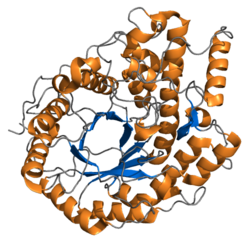Biology:B-amylase
Beta-amylase (EC 3.2.1.2, saccharogen amylase, glycogenase) is an enzyme with the systematic name 4-alpha-D-glucan maltohydrolase.[2][3][4] This enzyme catalyses the following chemical reaction
- Hydrolysis of (1->4)-alpha-D-glucosidic linkages in polysaccharides so as to remove successive maltose units from the non-reducing ends of the chains
This enzyme acts on starch, glycogen and related polysaccharides and oligosaccharides producing beta-maltose by an inversion. Beta-amylase is found in bacteria, fungi, and plants; bacteria and cereal sources are the most heat stable. Working from the non-reducing end, β-amylase catalyzes the hydrolysis of the second α-1,4 glycosidic bond, cleaving off two glucose units (maltose) at a time. During the ripening of fruit, β-amylase breaks starch into maltose, resulting in the sweet flavor of ripe fruit.
β-amylase is present in an inactive form prior to seed germination. Many microbes also produce amylase to degrade extracellular starches. Animal tissues do not contain β-amylase, although it may be present in microorganisms contained within the digestive tract. The optimum pH for β-amylase is 4.0–5.0[5]
See also
References
- ↑ "Chemical genetics and cereal starch metabolism: structural basis of the non-covalent and covalent inhibition of barley β-amylase". Molecular bioSystems 7 (3): 718–30. March 2011. doi:10.1039/c0mb00204f. PMID 21085740.
- ↑ "A crystalline beta-amylase from sweet potatoes". The Journal of Biological Chemistry 173 (1): 9-19. March 1948. PMID 18902365.
- ↑ "β-Amylases". The Enzymes. 4 (2nd ed.). New York: Academic Press. 1960. pp. 345–368.
- ↑ "Enzymic synthesis and degradation of starch and glycogen". Advances in Carbohydrate Chemistry 17: 371–430. 1962. doi:10.1016/s0096-5332(08)60139-3.
- ↑ "Amylase, Alpha" , I.U.B.: 3.2.1.11,4-α-D-Glucan glucanohydrolase.
External links
- Beta-amylase at the US National Library of Medicine Medical Subject Headings (MeSH)


